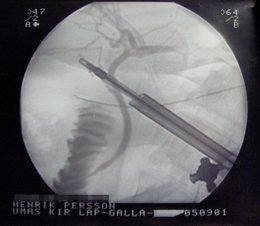Cholecystitis
Cholecystitis is inflammation of the gallbladder. It is commonly due to impaction (sticking) of a gallstone within the neck of the gall bladder, leading to inspissation of bile, bile stasis, and infection by gut organisms. Cholecystitis may be a cause of right upper quadrant pain. The pain may actually manifest in the right flank or scapular region at first. In severe cases, the gall bladder can rupture and form an abscess. In severe cases, it may lead to a life-threatening infection of the liver called cholangitis. In other cases, it may lead to a stable inflammatory state termed chronic cholecystitis. more...
Diagnosis
The classic patient with acute cholecystitis presents with acute right upper quadrant pain, nausea/vomiting, and fever. On physical examination, he or she has a Murphy's sign, which is a diaphragm spasm (due to the intense pain) when the region of the gall bladder is palpated by the examiner.
Laboratory values may be notable for an elevated alkaline phosphatase, possibly an elevated bilirubin (although this could indicate choledocholithiasis), and possibly an elevation of the white blood cell count. The degree of elevation of these laboratory values can be dependent on the degree of inflammation of the gallbladder. Patients with acute cholecystitis are much more likely to manifest abnormal laboratory values, while in chronic cholecystitis the laboratory values are frequently normal.
Radiology
Sonography is a sensitive and specific modality for diagnosis of acute cholecystitis; adjusted sensitivity and specificity for diagnosis of acute cholecystitis are 88% and 80%, respectively. The 2 major diagnostic criteria are cholelithiasis and sonographic Murphy's sign. Minor criteria include gallbladder wall thickening greater than 3mm, pericholecystic fluid, and gallbladder dilatation.
The reported sensitivity and specificity of CT scan findings are in the range of 90-95%. CT is more sensitive than ultrasonography in the depiction of pericholecystic inflammatory response and in localizing pericholecystic abscesses, pericholecystic gas, and calculi outside the lumen of the gallbladder. CT cannot see noncalcified gallbladder calculi, and cannot assess for a Murphy's sign.
Hepatobiliary scintigraphy with technetium-99m bilirubin analogs is also sensitive and accurate for diagnosis of acute cholecystitis, and can differentiate between acute and chronic forms of the disease. It can also assess the ability of the gall bladder to expel bile (gall bladder ejection fraction), and low gall bladder ejection fraction has been linked to chronic cholecystitis. However, since most patients with right upper quadrant pain do not have cholecystitis, primary evaluation is usually accomplished with a modality that can diagnose other causes, as well.
Read more at Wikipedia.org



